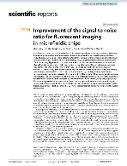Improvement of the signal to noise ratio for fluorescent imaging in microfluidic chips

Datum vydání
2022Publikováno v
Scientific ReportsRočník / Číslo vydání
12 (1)ISBN / ISSN
ISSN: 2045-2322Metadata
Zobrazit celý záznamKolekce
Tato publikace má vydavatelskou verzi s DOI 10.1038/s41598-022-23426-z
Abstrakt
Microfluidics systems can be fabricated in various ways using original silicon glass systems, with easy Si processing and surface modifications for subsequent applications such as cell seeding and their study. Fluorescent imaging of cells became a standard technique for the investigation of cell behavior. Unfortunately, high sensitivity fluorescent imaging, e.g., using total internal reflection fluorescence (TIRF) microscopy, is problematic in these microfluidic systems because the uneven surfaces of the silicon channels' bottoms affect light penetration through the optical filters. In this work, we study the nature of the phenomenon, finding that the problem can be rectified by using a silicon-on-insulator (SOI) substrate, defining the channel depth by the thickness of the top Si layer, and halting the etching at the buried SiO2 layer. Then the fluorescent background signal drops by = 5 times, corresponding to the limit of detection drop from = 0.05 mM to = 50 nM of fluorescein. We demonstrate the importance of a flat surface using TIRF-based single-molecule detection, improving the signal to a noise ratio more than 18 times compared to a conventional Si wafer. Overall, using very high-quality SOI substrates pays off, as it improves the fluorescence image quality due to the increase in signal-to-noise ratio. Concerning the cost of microfluidic device fabrication-design, mask fabrication, wafer processing, and device testing-the initial SOI wafer cost is marginal, and using it improves the system performance.
Klíčová slova
electrochemical impedance spectroscopy, X-ray-fluorescence, surface-roughness, electrochemiluminescence, proteins, progress
Trvalý odkaz
https://hdl.handle.net/20.500.14178/1822Licence
Licence pro užití plného textu výsledku: Creative Commons Uveďte původ 4.0 International






